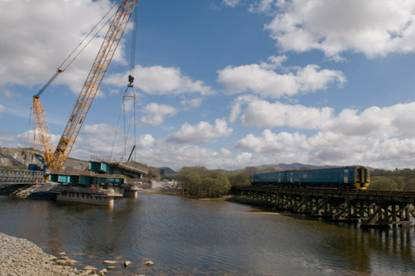A487 Porthmadog, Minfordd and Tremadog BypassHighly Commended CEEQUAL Outstanding Achievement Award 2013 for Ecology & Biodiversity |
|
Whole Project Award
Project Team
Client: Welsh
Government
Employer’s Agent: Halcrow
Group
Contractor’s Designer: Hyder
Consulting
Construction: Balfour
Beatty/Jones Bros JV
The project
Ever since 1993, the preferred bypass route for this scheme
has been waiting for the go-ahead. Until last year, the seaside town
of Porthmadog and the adjacent villages of Minfordd and Tremadog, continued
to suffer intolerable levels of vehicle congestion as tourists battled
with heavy lorries and other through-traffic in the narrow streets of
the town and villages.

Aerial Shot of Bypass
This is now a not too distant memory. Traffic wishing to use this vital north-south trunk route can do so with ease, sweeping over the Glaslyn River on a new three span bridge and bypassing the town and villages on a new 5.3km long, single carriageway road. Meanwhile the people and businesses in Porthmadog have been given their town back. Tourists can enjoy the high street and businesses can thrive in the pleasantly bustling centre.
With more efficient transport links comes benefits in carbon emissions
reduction – a prime objective for this project. Other advantages
include more efficient local public transport services, more attractive
cycling and pedestrian experiences, fewer accidents and improved air
quality.

Stone walling under construction
The construction phase had its challenges too. A temporary bailey bridge was installed over the Glaslyn to enable the 900,000 tonnes of locally quarried fill material to be brought directly to site. This avoided 106,000 lorry movements through the centre of Porthmadog, and its consequent disruption and emissions.

Articulated Dumptruck carrying stone from the quarry over the bailey
bridge direct to the site
All the 183,000m3 of excavated material was re-used in the scheme. Waste off site was minimal – limited to the general waste from the compound area which went to a Transfer Station.

Glaslyn Bridge construction, Bailey Bridge and Cambrian Coast mainline
A Scheduled Ancient Monument (Roman Bath House) was protected during construction, as were slow worms (capture & release), bats (route re-aligned and flight lines maintained), badgers (temporary artificial setts constructed), water quality (settlement lagoons, SUDS etc..), ancient hedgerow, 8,400m2 of valuable lowland dry acid grassland and wet woodland (all successfully translocated), and lichens (substrate relocated and placed in original orientation).
8,500m3 of Japanese knotweed infested material was sealed in an on-site cell under the guidance of the Environment Agency. This avoided 1,700 HGV journeys to a licensed landfill.
Habitats were improved or created for water vole, bats and reptiles with the 3,000m new stone walling being modified to contain reptile refugia in the rear elevation.
With four separate railway lines affected – Network Rail’s Cambrian Coast mainline, Ffestiniog Railway, Welsh Highland Railway and the Welsh Highland Heritage Railway, a working quarry, Porthmadog FC, Porthmadog Town Council, Gwynedd County Council and the local school; the liaison during the whole scheme delivery was extensive.
The Contractors provided the Aberglaslyn Mountain Rescue Team with two portacabins in the compound car park for storage and meeting and carried out work on the access track of their new premises, when they had to leave their former base.

Bridge construction over the Glaslyn River (Bailey Bridge in background)
To improve the visual impact of the scheme, overhead power cables were moved underground, embankment slopes slackened, screening bunds created and 52,000 trees and shrubs planted.


